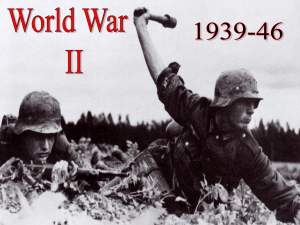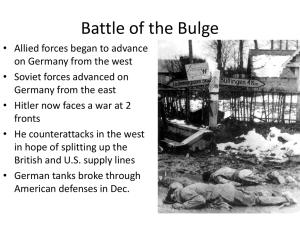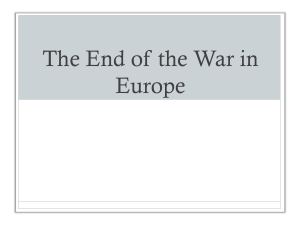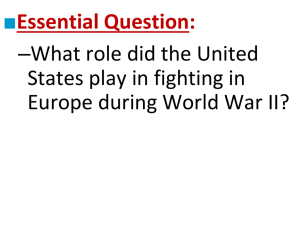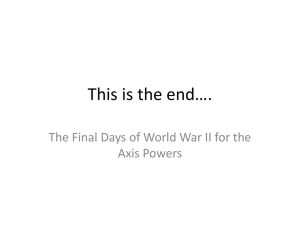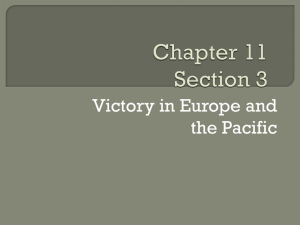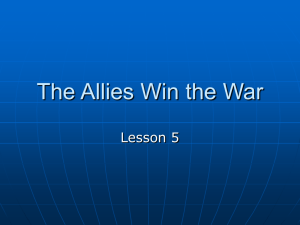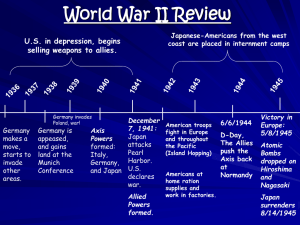11-3 Powerpoint
advertisement
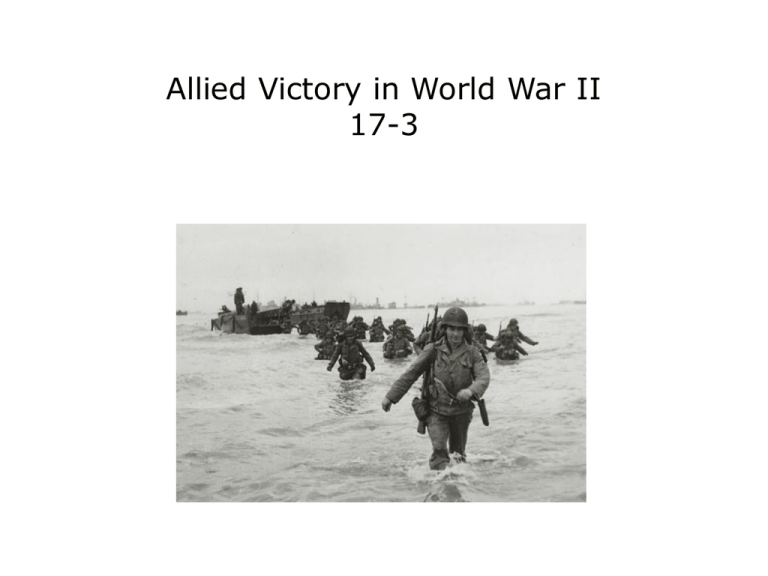
Allied Victory in World War II 17-3 Terms and People • D-Day − June 6, 1944, the day Allied forces invaded France • Battle of the Bulge − German counterattack that failed, resulting in an Allied victory • Harry S. Truman − President during the end of World War II • island hopping − American strategy of capturing selected islands in the Pacific in a steady path to Japan Terms and People (continued) • kamikaze − Japanese pilots who deliberately crashed their planes into American ships • Albert Einstein − world-famous scientist who alerted Roosevelt of the need to develop atomic weapons • Manhattan Project − code name for the program to develop an atomic bomb • J. Robert Oppenheimer − key leader of the Manhattan Project In 1943, Allied leaders agreed to open a second front in the war in Europe. American and British troops would cross the English Channel and invade France. • The secret operation was codenamed Operation Overlord. • General Dwight D. Eisenhower was the mission’s commander. Operation Overlord was a massive operation. It required careful planning and involved an elaborate hoax to fool the enemy about where troops would land. On D-Day, June 6, 1944, the Allies landed at Normandy. Amid intense fighting, the Allies captured the beaches. Within a month, more than one million troops landed in France. The Allies seized the momentum. The Americans and British advanced from the west, liberating Paris in August 1944. The Soviets advanced from the east, liberating Latvia, Romania, Slovakia, and Hungary. In December 1944, Hitler launched a counterattack, creating a bulge in the American lines. The Americans pushed back, forcing a German retreat during the Battle of the Bulge. The Allies soon surrounded Berlin, preparing for an all-out assault on Hitler’s capital Hitler had fallen into madness, giving orders that were not obeyed and planning attacks that were not carried out. In April 1945, Hitler committed suicide. Germany surrendered. World War II in Europe, 1942–1945 With the German surrender, the Allies celebrated V-E Day, hailing their hardfought victory in Europe. FDR did not live to join the celebrations. He died a few weeks earlier. The new President was Harry S. Truman. War still raged in the Pacific, where the Allies were fighting their way toward Japan. • Battles during the island-hopping campaign were fierce, with high casualties on both sides. • Kamikazes crashed into American ships. Japanese troops fought to the death. • An intense bombing campaign leveled much of Tokyo. Still, Japan refused to surrender. Iwo Jima • On February 19, 1945, 60,000 American Marines landed on Iwo Jima, • The terrain was rugged, with rocky cliffs, jagged ravines, and dozens of caves. • 6,800 lost their lives before the island was captured. Okinawa • E. Japan refused to surrender. American military planners chose to invade Okinawa, 350 miles from Japan, to stockpile supplies and build up troops. • F .On April 1, 1945, American troops landed on Okinawa. On June 22, 1945, Okinawa was captured with more than 12,000 American soldiers, sailors, and marines losing their lives. Two Battle • • • • US 18,900+ killed, 38,000 wounded + 33,096 non combat wounded, • 763 planes shot down • Japan • 76,000+ soldiers killed and 27,000 civilians killed, 7,455 surrendered/captured Something had to be done. Early in the war, Albert Einstein convinced FDR of the need to develop an atomic bomb. The program was codenamed the Manhattan Project. It was led by J. Robert Oppenheimer. The bomb was successfully tested in July 1945. So top secret Truman the VP didn’t know about it Now it was up to Truman to decide if and when to use it. The Japanese refused to surrender. An invasion of Japan could cost up to 1,000,000 American lives. Truman’s chief priority was to save American lives. On August 6, 1945, U.S. pilots dropped an atomic bomb on Hiroshima. Three days later, they dropped a second bomb on Nagasaki. On August 15, Emperor Hirohito surrendered. The Allies celebrated V-J Day, marking victory in Japan. The most costly war in history was finally over. World War II in the Pacific, 1942−1945
